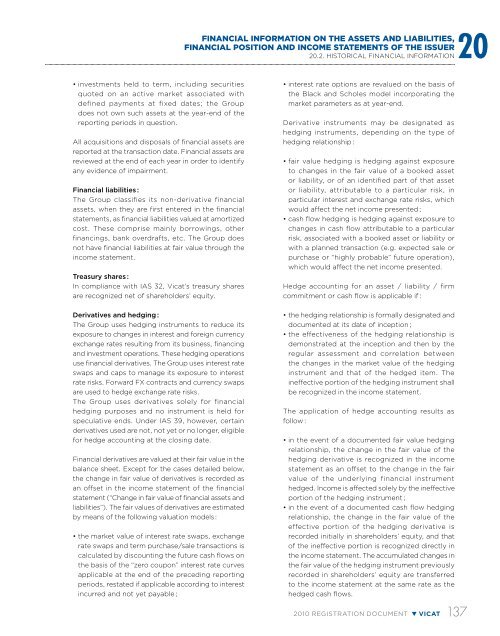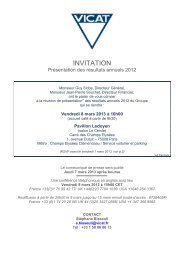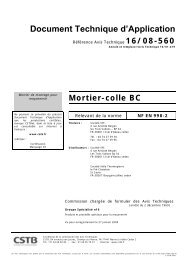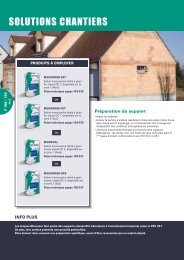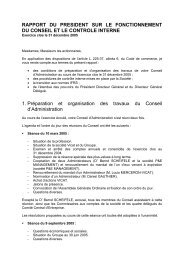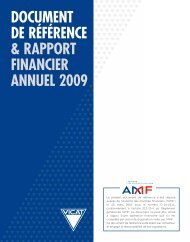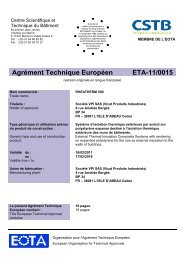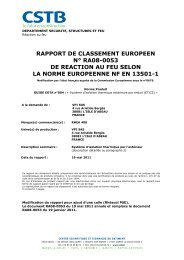6 - Vicat
6 - Vicat
6 - Vicat
You also want an ePaper? Increase the reach of your titles
YUMPU automatically turns print PDFs into web optimized ePapers that Google loves.
Financial information on the assets and liabilities,financial position and income statements of the issuer20.2. Historical financial information20• investments held to term, including securitiesquoted on an active market associated withdefined payments at fixed dates; the Groupdoes not own such assets at the year-end of thereporting periods in question.All acquisitions and disposals of financial assets arereported at the transaction date. Financial assets arereviewed at the end of each year in order to identifyany evidence of impairment.Financial liabilities :The Group classifies its non-derivative financialassets, when they are first entered in the financialstatements, as financial liabilities valued at amortizedcost. These comprise mainly borrowings, otherfinancings, bank overdrafts, etc. The Group doesnot have financial liabilities at fair value through theincome statement.Treasury shares :In compliance with IAS 32, <strong>Vicat</strong>’s treasury sharesare recognized net of shareholders’ equity.Derivatives and hedging :The Group uses hedging instruments to reduce itsexposure to changes in interest and foreign currencyexchange rates resulting from its business, financingand investment operations. These hedging operationsuse financial derivatives. The Group uses interest rateswaps and caps to manage its exposure to interestrate risks. Forward FX contracts and currency swapsare used to hedge exchange rate risks.The Group uses derivatives solely for financialhedging purposes and no instrument is held forspeculative ends. Under IAS 39, however, certainderivatives used are not, not yet or no longer, eligiblefor hedge accounting at the closing date.Financial derivatives are valued at their fair value in thebalance sheet. Except for the cases detailed below,the change in fair value of derivatives is recorded asan offset in the income statement of the financialstatement (“Change in fair value of financial assets andliabilities”). The fair values of derivatives are estimatedby means of the following valuation models :• the market value of interest rate swaps, exchangerate swaps and term purchase/sale transactions iscalculated by discounting the future cash flows onthe basis of the “zero coupon” interest rate curvesapplicable at the end of the preceding reportingperiods, restated if applicable according to interestincurred and not yet payable ;• interest rate options are revalued on the basis ofthe Black and Scholes model incorporating themarket parameters as at year-end.Derivative instruments may be designated ashedging instruments, depending on the type ofhedging relationship :• fair value hedging is hedging against exposureto changes in the fair value of a booked assetor liability, or of an identified part of that assetor liability, attributable to a particular risk, inparticular interest and exchange rate risks, whichwould affect the net income presented ;• cash flow hedging is hedging against exposure tochanges in cash flow attributable to a particularrisk, associated with a booked asset or liability orwith a planned transaction (e.g. expected sale orpurchase or “highly probable” future operation),which would affect the net income presented.Hedge accounting for an asset / liability / firmcommitment or cash flow is applicable if :• the hedging relationship is formally designated anddocumented at its date of inception ;• the effectiveness of the hedging relationship isdemonstrated at the inception and then by theregular assessment and correlation betweenthe changes in the market value of the hedginginstrument and that of the hedged item. Theineffective portion of the hedging instrument shallbe recognized in the income statement.The application of hedge accounting results asfollow :• in the event of a documented fair value hedgingrelationship, the change in the fair value of thehedging derivative is recognized in the incomestatement as an offset to the change in the fairvalue of the underlying financial instrumenthedged. Income is affected solely by the ineffectiveportion of the hedging instrument ;• in the event of a documented cash flow hedgingrelationship, the change in the fair value of theeffective portion of the hedging derivative isrecorded initially in shareholders’ equity, and thatof the ineffective portion is recognized directly inthe income statement. The accumulated changes inthe fair value of the hedging instrument previouslyrecorded in shareholders’ equity are transferredto the income statement at the same rate as thehedged cash flows.2010 registration document VICAT 137


